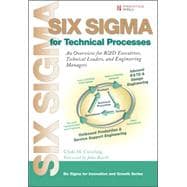
What is included with this book?
| Foreword | p. xiii |
| Preface | p. xv |
| About the Author | p. xxi |
| Introduction to Six Sigma for Technical Processes | p. 1 |
| Scorecards for Risk Management in Technical Processes | p. 21 |
| Project Management in Technical Processes | p. 35 |
| Strategic Product and Technology Portfolio Renewal Process | p. 51 |
| Strategic Research and Technology Development Process | p. 95 |
| Tactical Product Commercialization Process | p. 163 |
| Fast Track Commercialization | p. 275 |
| Operational Post-Launch Engineering Support Processes | p. 293 |
| Future Trends in Six Sigma and Technical Processes | p. 317 |
| Glossary | p. 323 |
| Index | p. 35 |
| Table of Contents provided by Publisher. All Rights Reserved. |
The New copy of this book will include any supplemental materials advertised. Please check the title of the book to determine if it should include any access cards, study guides, lab manuals, CDs, etc.
The Used, Rental and eBook copies of this book are not guaranteed to include any supplemental materials. Typically, only the book itself is included. This is true even if the title states it includes any access cards, study guides, lab manuals, CDs, etc.